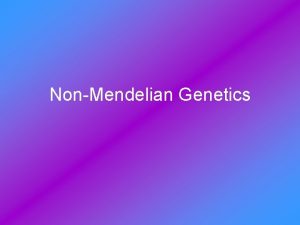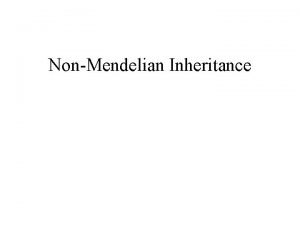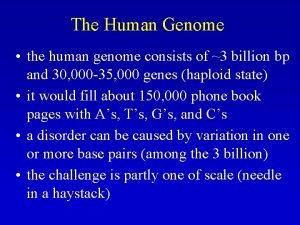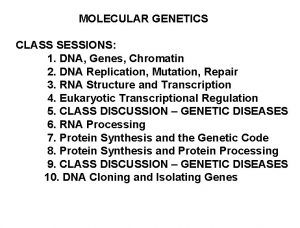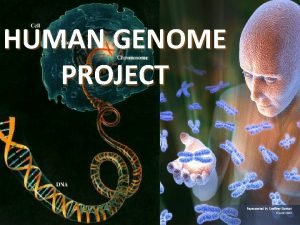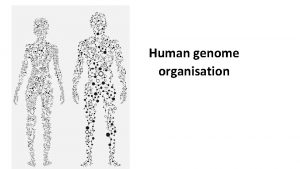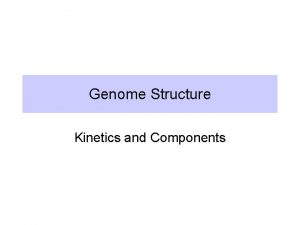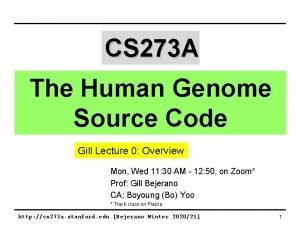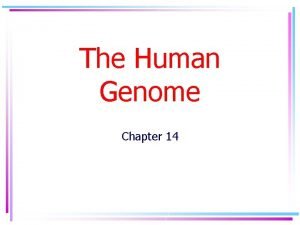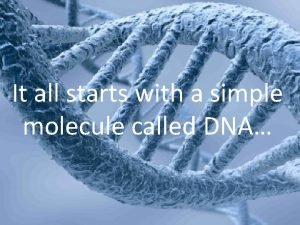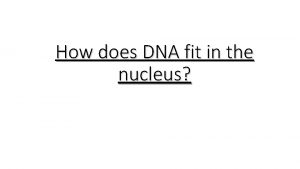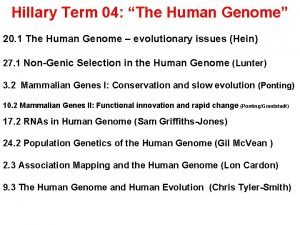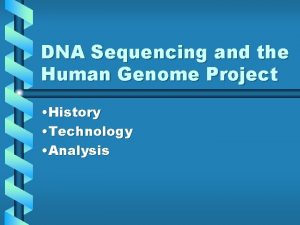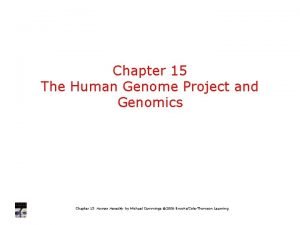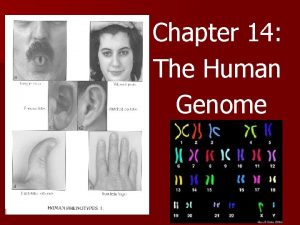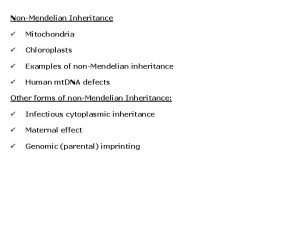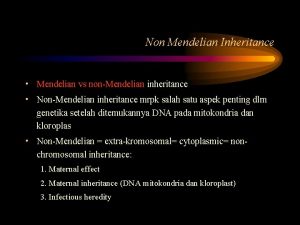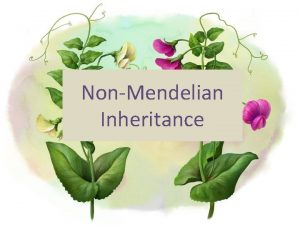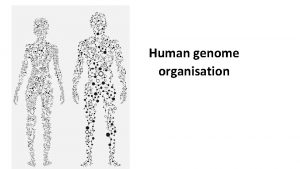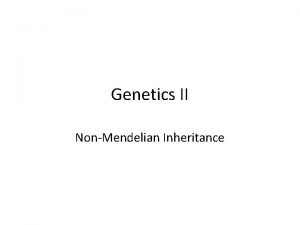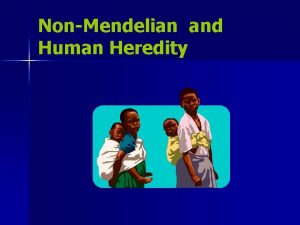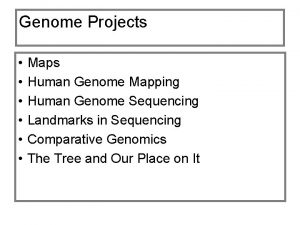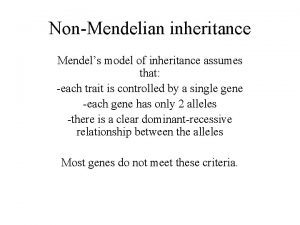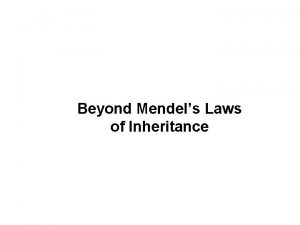NonMendelian Inheritance and Human Genome Polygenetic Inheritance a
















- Slides: 16

Non-Mendelian Inheritance and Human Genome

Polygenetic Inheritance -a trait is controlled by more than two alleles Ex. Skin color Fig. 14 -13 Aa. Bb. Cc Sperm 1/ Eggs 1/ 8 1/ 1/ 8 8 1/ 64 15/ 8 1/ 1/ 8 8 8 1/ 8 Aa. Bb. Cc 8 1/ Phenotypes: 64 Number of dark-skin alleles: 0 6/ 64 1 15/ 64 2 20/ 3 64 4 6/ 64 5 1/ 64 6

Sex Determination Gametes - -egg & sperm - originate from sex cells haploid -23 chromosomes Zygote - - when sperm & egg unite = fertilization -out of 46 only 2 are sex chromosomes = X & Y - -XX = female, XY = male -44 are autosomes- code for everything else


Sex Linked Genes - -Carried on only the X or Y chromosome - -Ex: Color blindness is a recessive trait carried only on the X chromosome (XCB). A female needs to be XCB to get it, but a male only has to be XCB Y to get it. So more males are color blind.

Numbers That You Should See If You Are In One Of The Following Four Categories: [Some Letter Choices Show No Visible Numbers] 4 Sex-Linked Traits: 1. Normal Color Vision: A: 29, B: 45, C: --, D: 26 2. Red-Green Color-Blind: A: 70, B: --, C: 5, D: -3. Red Color-blind: A: 70, B: --, C: 5, D: 6 4. Green Color-Blind: A: 70, B: --, C: 5, D: 2

Pedigree- a chart showing genetic inheritance

Incomplete Dominance the alleles are blended together to form an intermediate phenotype - example: snap dragon color (red, white or pink)

Incomplete Dominance Flower color RR= Red R’R’= White RR’= Pink

Co-Dominance - Both alleles are expressed in the phenotype (ex. Sickle cell anemia) BB= normal cell bb=sickle cell Bb Both (carrier)

Multiple alleles -Blood Type -Co-dominant -caused by multiple alleles – 3 or more forms - A = has only A carbs. (can act as antigens and cause a immune system reaction) - B = has only B carbs. - AB = both AB carbs. - O = no carbs.

Fig. 14 -11 Allele IA IB Carbohydrate A B i none (a) The three alleles for the ABO blood groups and their associated carbohydrates Genotype Red blood cell appearance Phenotype (blood group) IAIA or IA i A IBIB or IB i B IA IB AB ii O (b) Blood group genotypes and phenotypes

RH factor -Rhesus factor- antigens on the surface of blood cells that can cause an immune response - two types - Positive (+) contain the antigens - Negative (-) do not contain the antigens -a negative mother could harm a positive fetus. -a negative person getting positive blood can be seriously harmed.

Epistasis • A gene at one locus alters the expression of another gene Bb. Cc Sperm Eggs 1/ 1/ 4 BC 1/ 4 b. C Bb. Cc 1/ 4 Bc 1/ 4 bc BBCC Bb. CC BBCc Bb. CC bb. CC Bb. Cc bb. Cc BBCc Bb. Cc BBcc Bb. Cc bb. Cc Bbcc bbcc 4 b. C 4 Bc 4 bc 9 : 3 : 4

Pleiotrophy • Some genes control more than one trait. (ex. Pea flower and seed color are controlled by one gene, a genes for body size affects litter size, in humans a gene linked to eye color also skin tone. )

Multifactorial genetics • Multifactorial traits are affected by genotype and the Fig. 14 -14 environment • Norm of reaction-phenotype range (more acid or aluminum results in darker flowers
 Nonmendelian traits
Nonmendelian traits Semi-global alignment
Semi-global alignment Polygenetic trait
Polygenetic trait Euphenics
Euphenics Human genome size
Human genome size Human genome size
Human genome size Human genome features
Human genome features Satellite dna
Satellite dna Human genome structure
Human genome structure Human genome project source code
Human genome project source code Chapter 14 the human genome making karyotypes answer key
Chapter 14 the human genome making karyotypes answer key National human genome research institute
National human genome research institute National human genome research institute
National human genome research institute Human genome project
Human genome project History of human genome project
History of human genome project Chapter 15 the human genome answer key
Chapter 15 the human genome answer key Chapter 14 the human genome
Chapter 14 the human genome
